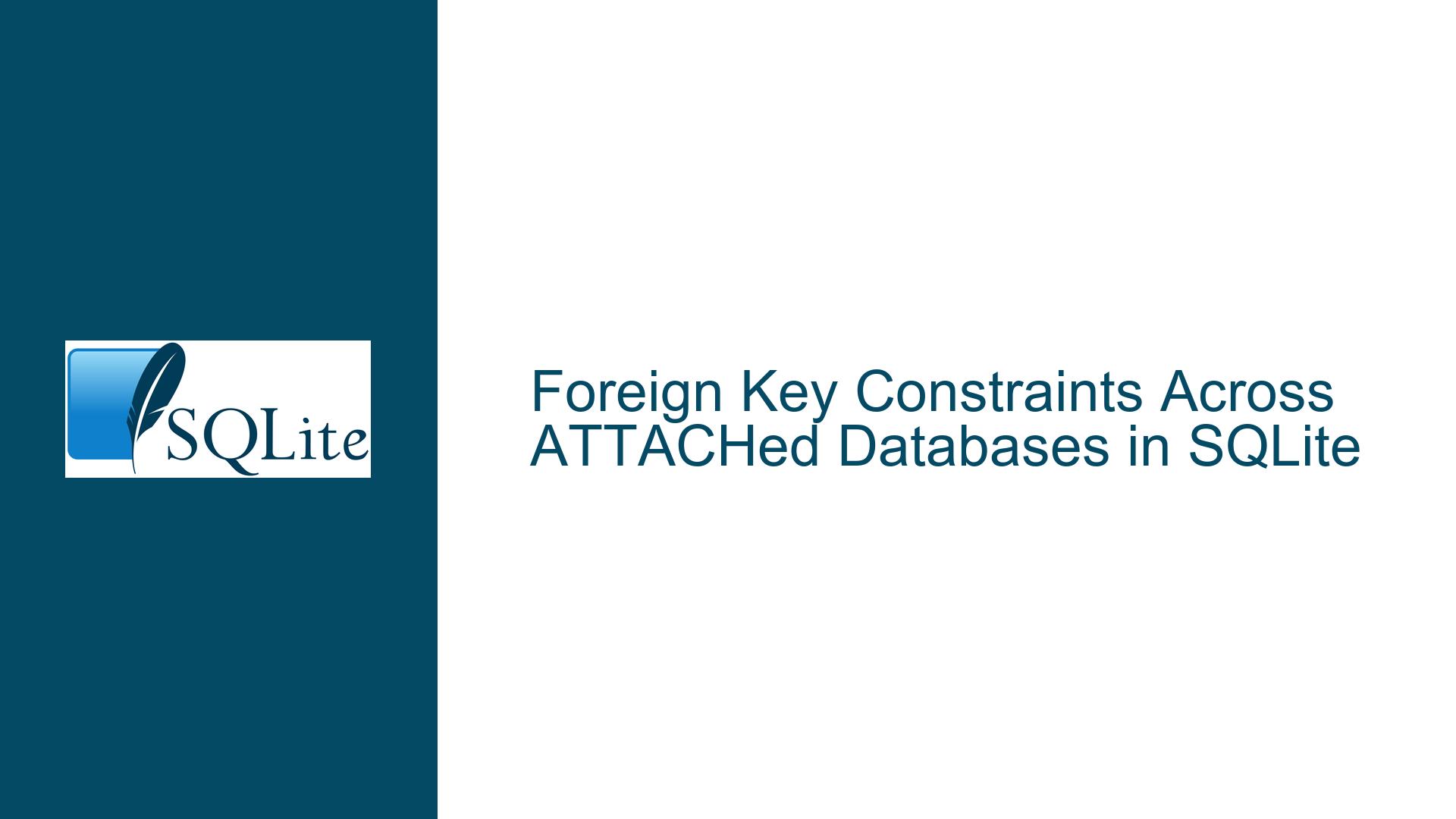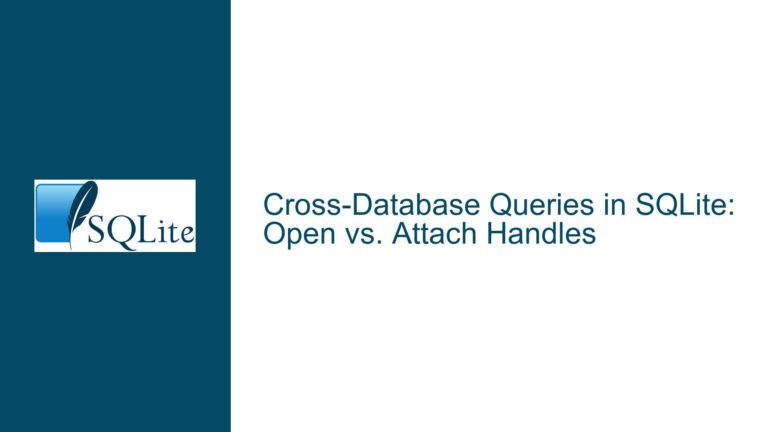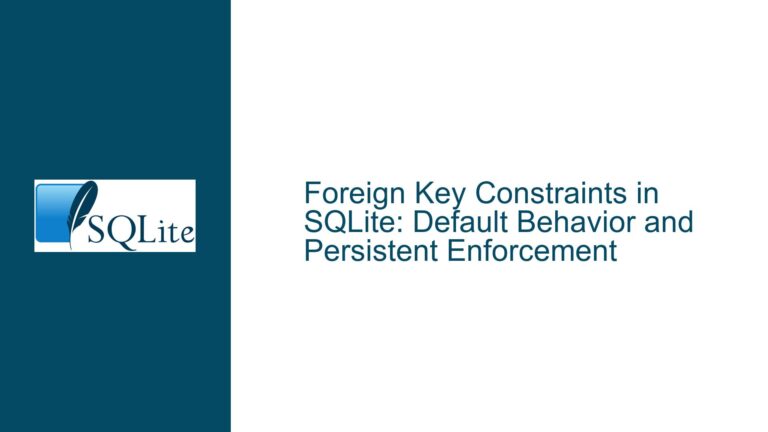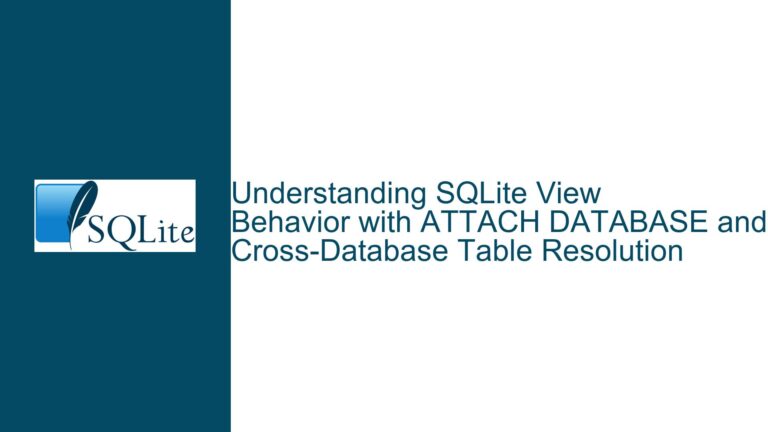Foreign Key Constraints Across ATTACHed Databases in SQLite
Understanding the Limitations of Foreign Keys in ATTACHed Databases
SQLite is a powerful, lightweight database engine that supports a wide range of features, including foreign key (FK) constraints, which are essential for maintaining referential integrity between related tables. However, one notable limitation is the lack of support for foreign key constraints across ATTACHed databases. This limitation arises from the way SQLite handles database files and transactions, particularly when dealing with multiple databases that are ATTACHed to a single connection.
When you ATTACH a database in SQLite, it allows you to access tables from multiple database files within the same connection. This feature is particularly useful for organizing data into separate files for modularity, security, or performance reasons. However, SQLite does not allow foreign key constraints to reference tables in ATTACHed databases. This means that if you have a parent table in one database and a child table in another, you cannot enforce a foreign key relationship between them directly.
The primary reason for this limitation is the potential for inconsistency in multi-database transactions, especially in scenarios involving power loss or system crashes. SQLite ensures atomicity and durability within a single database file, but these guarantees become more complex when transactions span multiple files. For instance, if a transaction involves updates to both a parent table in one database and a child table in another, a power loss could result in partial updates, leaving the databases in an inconsistent state. This inconsistency could violate foreign key constraints, leading to data integrity issues.
Exploring the Technical Challenges of Cross-Database Foreign Keys
The technical challenges of implementing foreign key constraints across ATTACHed databases are rooted in SQLite’s transaction management and journaling mechanisms. SQLite uses a write-ahead log (WAL) or rollback journal to ensure atomic transactions within a single database file. However, these mechanisms do not extend seamlessly to multiple database files, particularly when those files are ATTACHed to the same connection.
One of the key issues is the handling of super-journal files, which are used to coordinate transactions across multiple databases. In WAL mode, SQLite ensures that individual database files are updated atomically, but this guarantee does not extend to multi-file transactions. If a power loss occurs during a multi-file transaction, some databases might roll back while others roll forward, leading to potential inconsistencies. This inconsistency is particularly problematic for foreign key constraints, as they rely on the integrity of relationships between tables.
Another challenge is the dynamic nature of ATTACHed databases. Since databases can be ATTACHed and DETACHed during runtime, enforcing foreign key constraints across these databases would require SQLite to continuously monitor the presence and state of the referenced tables. If a referenced database is DETACHed, SQLite would need to handle the resulting foreign key violations gracefully, which adds complexity to the implementation.
Furthermore, the current design of SQLite’s foreign key mechanism assumes that all referenced tables are within the same database file. This assumption simplifies the enforcement of foreign key constraints, as SQLite can rely on the atomicity and durability guarantees provided by the single database file. Extending this mechanism to support cross-database foreign keys would require significant changes to SQLite’s core architecture, including the transaction management and journaling systems.
Implementing Workarounds and Best Practices for Cross-Database Relationships
Given the limitations and technical challenges of implementing foreign key constraints across ATTACHed databases, developers must rely on alternative strategies to enforce referential integrity between tables in separate database files. One common approach is to use application-level logic to enforce relationships between tables in different databases. This involves writing custom code to validate and maintain the integrity of cross-database relationships, such as checking for orphaned records or ensuring that related records are updated or deleted together.
Another approach is to use triggers to enforce referential integrity across ATTACHed databases. While SQLite does not support cross-database foreign keys, it does allow triggers to reference tables in ATTACHed databases. By creating triggers on the child table, you can enforce constraints that mimic foreign key behavior. For example, you can create a BEFORE INSERT trigger on the child table to check if the corresponding parent record exists in the ATTACHed database. Similarly, you can create triggers to handle updates and deletes, ensuring that changes to the parent table are propagated to the child table.
However, using triggers to enforce referential integrity has its own set of challenges. Triggers can introduce performance overhead, particularly if they involve complex queries or multiple database files. Additionally, triggers do not provide the same level of atomicity as foreign key constraints, as they are executed within the context of the current transaction. This means that if a transaction involving multiple databases fails, the triggers may not be able to fully roll back the changes, leading to potential inconsistencies.
A more robust approach is to consolidate related tables into a single database file, eliminating the need for cross-database relationships altogether. While this approach may not be feasible for all use cases, it simplifies the database schema and ensures that foreign key constraints can be enforced natively by SQLite. If modularity or security concerns require separate database files, consider using views or virtual tables to provide a unified interface to the data, while keeping the underlying tables in separate files.
In conclusion, while SQLite does not currently support foreign key constraints across ATTACHed databases, developers can use a combination of application-level logic, triggers, and schema design to enforce referential integrity between tables in separate database files. By understanding the limitations and technical challenges of cross-database relationships, you can make informed decisions about how to structure your database schema and implement workarounds that meet your application’s requirements. As SQLite continues to evolve, future versions may introduce new features or enhancements that address these limitations, providing more robust support for cross-database foreign keys. Until then, careful planning and thoughtful implementation are key to maintaining data integrity in multi-database environments.






